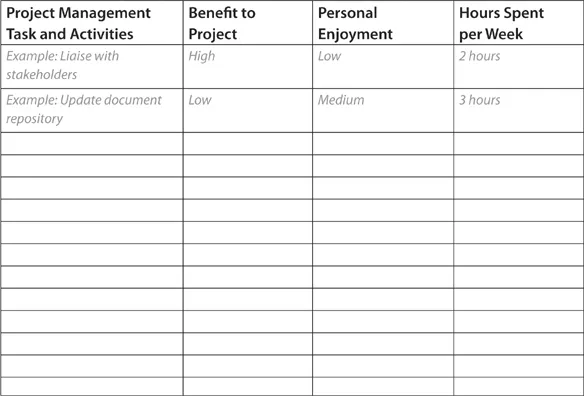![]()
STEP 1
What Do You Want to Achieve? Create Your Vision and Mission Statement
Knowing what you want to achieve is the first step in becoming as successful as possible. Only when you know what you are aiming for can you reach your goals and fulfill your ambitions.
The subconscious mind works to achieve the things that you think about most of the time, whether you want them or not. This is why I encourage you to switch your thinking away from what you do not want to what you do want.
The first part of this workbook, Step 1, is designed to make you think about what kind of project manager you want to become. Which qualities would you like to be known for, and what would you like to achieve in your career as a project manager? How do you define success, and what does excellence look like to you? There are many ways of achieving excellence, but you are the only one who can determine what it means to you.
I will guide you through a number of insightful questions that relate to your personal characteristics and to your behavior as a project manager. I will also ask you to write a vision and mission statement that encapsulates who and what you would like to be, do, and have. The vision and mission statement becomes your beacon and measure of success.
After completing Step 1 you will know what your strengths and challenges are as a project manager, what your goals are and what success means to you. A discussion of specific project management tips, tools, and techniques will follow shortly. But first we need to know a bit about who you are and what you want to achieve in your career as a project manager.
WHAT IS PROJECT MANAGEMENT?
Project management is about establishing what is in scope and out of scope of a project and subsequently organizing and managing resources in such a way that specific goals and objectives are achieved within a certain set of criteria.
Project management is the art and science of making a project’s vision come alive and getting things done—more so than determining what the vision itself is. Of course, there will be no project without a vision and clear objectives, but determining the “why and what” of a project is more a concern for the customer or change manager than for the project manager.
You could say that change management provides the project’s vision and is concerned with the human impact of change, whereas project management is related to how that vision is executed. These two disciplines go hand in hand and are both concerned with the transformation process between a present and a future state. The more experienced you become, the more likely it is that you will take on the role of a change manager in addition to your role as project manager.
Project management involves many different types of activities that all serve the purpose of ensuring that the project’s vision is executed and turned into reality within certain time, quality, and budget constraints. These activities relate to planning and coordinating tasks and to directing and supervising people. Scope and deliverables need to be specified, estimated, and executed, and quality must be assured. Risks, issues, and change requests need to be effectively managed, and a significant amount of time needs to be spent liaising with stakeholders and ensuring that the team remains focused and motivated.
In accordance with the philosophy that you manage tasks and lead people, it could be argued that project management contains an equal number of management and leadership activities. On that basis, we could go on to define project management as:
The management role that defines, plans, coordinates, and controls a project’s scope and operational activities, and the leadership role that inspires and focuses everyone contributing to the successful completion of the project’s goals and objectives.
To become a highly valued and truly successful project management leader, you need to be an excellent manager as well as a good leader. You must be able to access and make use of both skill sets, depending on the immediate need and the situation to which you are responding. In addition, you must be excellent at managing your time and consistently focus on the right activities. Some of the activities you engage in are essential to the dynamics and ongoing progress of the project and must be completed by you. Others are less important and could potentially be delegated to someone else.
Doing something very well that does not need to be done at all is a poor use of time. Before starting any activity, check how important it is to the overall success of the project or to the functioning of the team. Aim to always focus on the highest-value activities and delegate or defer the others. The tasks and activities that matter the most must never be at the mercy of the tasks and activities that matter the least.
Exercise: Project Management Activities
1. Brainstorm all of the tasks and activities that, in your experience, form part of a project manager’s job. Consider aspects that relate to the management of tasks as well as people. Write them down on a separate piece of paper.
2. Write each of the project management activities you identified in the leftmost column of the table below.
3. Assign a high, medium, or low rating to each activity depending on how much you believe it benefits your current project.
4. Next, assign each activity a high, medium, or low rating depending on how much you personally enjoy the activity.
5. Indicate how many hours per week you typically spend on each activity.
6. Look at how you rated the activities in terms of how much benefit they add to your current project. Which activities have you identified as adding the most benefit?
7. Which of the high-benefit activities do you need to spend relatively more time on in order to maximize your value to the project, and which lower-value activities can you spend less time on?
8. Examine the items that add a lot of benefit but which you do not particularly enjoy doing. How can you either make them more enjoyable or delegate them to someone else without jeopardizing the success of the project?
9. To add more weight to this exercise, talk it through with your manager. Get her views on what your tasks and responsibilities are and what you need to be spending relatively more or less time on.
MANAGEMENT VS. LEADERSHIP
The concepts of management and leadership are recurring themes throughout this workbook. I have chosen to use the word management to describe anything that relates to the control and direction of tasks, events, and processes, and leadership for anything that relates to the control and direction of people. On that basis, leadership and management encompass different but overlapping elements. It is possible to be good at one but not the other. It is, however, also possible to be good at both disciplines at the same time.
As a manager, you are typically involved in scheduling work, delegating tasks, coordinating effort and resources, monitoring and guiding progress, building teams, and appealing to rational thinking. As a leader, however, your role is to inspire people, explain goals, share the vision, provide focus, be a role model, monitor morale, create a positive team feeling, and unleash potential.
Field Marshal William Slim elegantly explained the difference between leadership and management in the following way: “Leadership is of the spirit, compounded of personality and vision. Its practice is an art. Management is of the mind, more a matter of accurate calculations, statistics, methods, timetables, and routine. Its practice is a science”.
One of the biggest differences between managers and leaders is the way they motivate people who work for them. Managers are in a position of authority, and their subordinates largely do as they are told because they get a reward (or a salary) for doing so. Leaders see their role quite differently and typically offer more creative opportunities when it comes to motivating staff. Leaders focus on inspiring people and on giving credit to others. They focus on the overall vision and end goal and on how they can best engage and serve others so that they in turn feel inspired and motivated to contribute to the vision.
Leaders tend to have followers rather than subordinates. They do not tell people what to do; that would not inspire them to follow. People follow because they feel inspired and because they want to contribute, not because they are told to.
Many associate the word leader with a particular role, such as the CEO of a major company. But leadership is not a function of what you do or what your job title is; rather, it is a function of your personal capabilities. Leaders can be found in many guises and in all walks of life; many parents, for instance, are leaders.
Exercise: Management and Leadership Activities
Think about project management and how it overlaps with general management and leadership.
1. Make a list of typical project management activities that fall within the classic discipline of management.
2. Make a similar list of project management activities that predominantly reside within the discipline of leadership.
3. In which situations would you benefit from acting more like a leader than a manager, and vice versa?
We will be examining the concept of leadership throughout this workbook and will assess what you can do to actively incorporate some of the most important qualities of leadership into the way you interact with your team and project stakeholders.
WHAT IS A GOOD PROJECT MANAGER?
Managing projects requires a great deal of effort, skill, and finesse. As a project manager, you are expected to engage with a big-picture vision and make a certain promise to execute it and turn it into reality within certain time, quality, and budget constraints. This requires thoughtful consideration and a great deal of skill and personal leadership. It requires you to fully understand the vision, scope, and constraints of the project and to continually work to remove blockages. You must consistently spend time on those things that matter the most to the success of the project, and you must focus on people as much as you focus on tasks.
There are as many ways of executing a project as there are people. We all have different ways of doing things...






